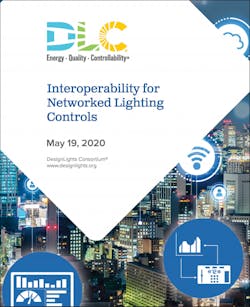The DesignLights Consortium (DLC) has published a report titled “Interoperability for Networked Lighting Controls” that explores the benefits of interoperability between LED-centric solid-state lighting (SSL) systems, other building systems, and utility systems. Natural Resources Canada funded the report that identifies actual use cases that benefit from interoperability and fully explores the way interoperability at the device, building system, and utility system levels delivers specific benefits in three of the use cases.
The new report will accomplish several things for the DLC. It makes a clear case for the use of networked lighting controls (NLCs). It defines interoperability and how to measure benefits. And it lays the groundwork for the DLC’s coming Version 5 (V5) of its NLC specification called NLC5.
“This report provides new insight about the importance of NLC interoperability for energy savings and other value-added benefits, as well as the barriers associated with achieving greater interoperability,” said DLC executive director and CEO Christina Halfpenny. “We also view this as a jumping off point for lighting industry stakeholders to collaborate and make progress toward the recommended interventions outlined in the report.”
The DLC has an established history endorsing the use of NLC technology and the benefits that NLCs afford many stakeholders, starting with SSL manufacturers and extending to contractors and building/facility operators and ending with the electrical utility. Indeed, the DLC authored a feature article that we published on the topic back in 2018.
The organization has also produced prior reports on the benefits of NLCs including a collaboration with the Alliance to Save Energy last year. The DLC published the existing NCL4 requirements back in mid-2019.
Understanding interoperability is a key aspect of the new report. It sounds like such a simple concept. For instance, we all rely on Wi-Fi to access the Internet and we fully trust that anywhere in the world our devices will work with available Wi-Fi hotspots — despite the fact that there are dozens of variations of Wi-Fi developed over the past two decades.
Still, the DLC report has adopted a higher-level view of interoperability. The report adopts the definition of the Smart Electric Power Alliance that states interoperable devices or systems must be capable of exchanging actionable data. That may or may not mean that every sensor in a building uses the same connectivity scheme or has the ability to communicate with every control panel, but that ultimately actionable data can flow from devices such as sensors to SSL systems to building systems and beyond.
The report illustrates the interoperability concept through the aforementioned uses cases. There are 32 such use cases in the report appendices. The three utilized in the body of the report are:
- External systems integration — Use occupancy data from NLC to inform HVAC operation
- Load shedding/demand response — Real-time dispatching and reporting for demand management, between NLC and another system including a utility system
- Energy monitoring — Energy data reporting to a utility incentive program to verify savings
The chief tool for supporting interoperability is application programming interfaces (APIs) implemented by devices and systems. Ultimately, interoperability will require standardization of data formats specific to use cases, and support for accessing the data via APIs. Indeed, the use cases will drive the interoperability effort.
The NLC5 draft includes a multi-year plan for addressing interoperability. And the report will help guide the path forward through the definition of what the authors called interventions intended to encourage manufacturers and standards organizations to proceed in a manner in which interoperability is more easily achieved.
Interested parties can download the full report. Moreover, the DLC will hold a webcast on the report June 4.
For up-to-the-minute LED and SSL updates, why not follow us on Twitter? You’ll find curated content and commentary, as well as information on industry events, webcasts, and surveys on our LinkedIn Company Page and our Facebook page.






